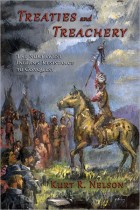Caxton Press, $18.95, 280 pages
Native Americans have had a long and tortured history with white settlers; from the Trail of Tears in the southeast to the Indian Wars that ravaged the Midwest and Great Plains. They have been decimated by diseases that they did not have immunity against and lack the strength in numbers to really fight back. In the end, they are forced to give up and live on reservations or die fighting.
In this book, author Kurt Nelson explores the relations between Native Americans and white settlers in the Pacific Northwest; an area that is largely ignored by historians. Along the way we see how the Governors of both territories attempted to force unfair treaties on the tribes and even then break them immediately. The white settlers often started the violence and did not distinguish between those that wanted peace and those that fought.
Mr. Nelson argues that most of the blame should be with the white settlers, and this is true. They generally brought it upon themselves by not treating the tribes with fairness. Also they felt the only good Indian was a dead Indian, no attempt at all for peace. The picture is stark, but Mr. Nelson brings it to life.
Kevin Winter

